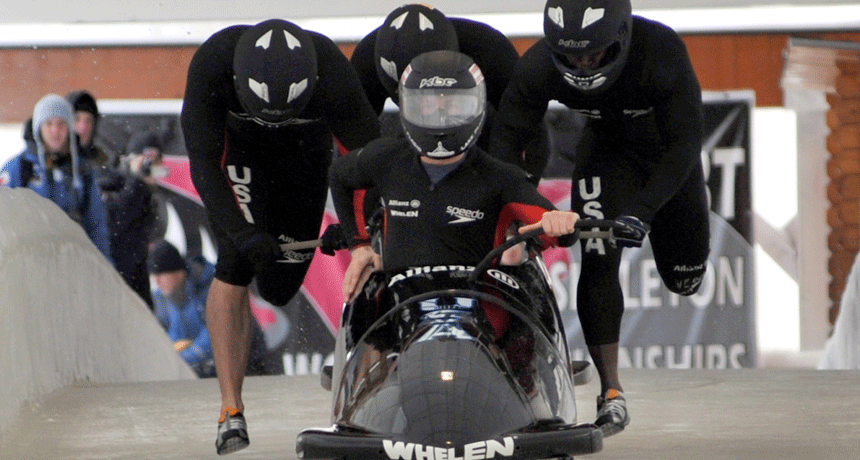In bobsledding, what the toes do can affect who gets the gold
How much spring are in the toes of bobsled shoes can be a key part of who medals at the Olympics

How fast bobsled athletes run down the start of the track can make or break the race.
Tim Hipps/U.S. Army
The bobsled teams competing at this year’s Winter Olympics in PyeongChang, South Korea, are hoping to start on the right foot. And that begins with the right shoes. So perhaps it’s no surprise that footwear scientists in South Korea have been hard at work building a better bobsled shoe for their home team.
Bobsledding is one of the fastest winter sports. Only 0.001 second can make the difference between bringing home a silver medal or gold. That’s in a race that only takes 60 seconds. And the most important part of that race takes place in just the first six seconds.
In bobsled, one, two or four athletes race down a track in an enclosed sled, propelled just by gravity. Most of a team’s success depends on what it does before the clock even begins. That’s during the first 15 meters (49 feet) of the “push start” — when they push the sled across the icy track, just before jumping in. Shortening the time by just 0.01 second could shorten the finishing time by 0.03 second, recent studies have shown. That’s more than enough to make the difference between a gold medal and disappointment.
“Thirty to 40 percent of the race outcome is decided by the push start,” says Alex Harrison. He would know. Harrison used to be a bobsled racer (and probably would have gone to the 2018 Winter Olympics if he hadn’t hurt his foot last fall). He also studied the bobsled push start as a graduate student at East Tennessee State University in Johnson City. Now, as a sports physiologist, he studies how physical activity affects the body.
Being fast helps with the push start, but it’s not enough. Bobsled athletes also have to be strong, especially in the legs, Harrison notes. Large tissue fibers known as fast twitch muscles help with short, powerful bursts of movement. That’s why sprinters make for good bobsledders. Their muscles are already primed for these fast starts.
The athletes need to keep their knees and feet low to the ground during the push start. This ensures they don’t waste time and energy bringing the foot back around. Instead, their foot — and their shoes — spend more time pushing against the ice.
And that’s why a bobsledder’s shoes are incredibly important. Similar to track cleats, these shoes have spikes on the soles. But instead of six or eight large spikes, they have at least 250 small ones. Those spikes help grip the ice, giving the athlete more traction to propel themselves forward.
Nearly every bobsled team member wears the same brand of shoes. They’re from Adidas, the only company that makes them for the sport. But those shoes may not be best for everyone, Harrison points out, since not every person is shaped the same.
Building a better shoe
Seungbum Park works at the Footwear Industrial Promotion Center in Busan, South Korea. His work focuses on the interplay between a bobsledders foot and shoe. It is very important and would pave the way to developing bobsled shoes that are better for South Korea’s national team.
Park’s group started by filming bobsledders. High-speed cameras focused on the feet as athletes ran wearing various shoes. Each shoe had reflective markers attached to the front and middle. This let the researchers see how the front of the foot bent in different shoes.
That bend is key.
As running speed increases, the foot bends more. This provides the driving force and spring that propels the athlete forward. If shoes don’t allow the foot to bend enough, they can limit the foot’s motion and limit an athlete’s performance.
But the researchers found that shoes that were the most flexible weren’t the best. Ones with soles that had harder middle and outer layers helped the athletes run faster. The team published its initial findings in 2016.
“A stiffer shoe will transfer force better to the ground,” Harrison notes. In most people, the big muscles in the legs will overpower the little muscles of the feet. But a stiffer sole allows the foot to become artificially stronger, allowing a faster start. The foot needs to bend, but it also needs to be strong.
Soles aren’t the only important part of a shoe. Some shoes, including bobsled shoes, point slightly upward at the toes. This is known as the “toe spring angle.”
After their first study, the Korean group went back to the bobsledders. This time, they tested them in shoes having three different toe angles: 30, 35 and 40 degrees. Shoes with the greatest toe-spring angle — 40 degrees — led to the best performances, they showed. These shoes gave bobsledders the best bend to their feet, driving them forward and shortening their start time. The scientists shared their new findings in September 2017 Korean Journal of Sport Biomechanics.
Harrison says a good bobsled shoe needs to be stiff, but also to bend enough to allow athletes to lean the shins and body forward and down during the first 10 meters (33 feet). “It looks like [the Koreans] accomplished that in a big way,” he says.
This shoe research could improve start times for the Korean bobsledders by 6 to 10 hundredths of a second. “That can certainly be the difference in making the medals or not,” Harrison says.







